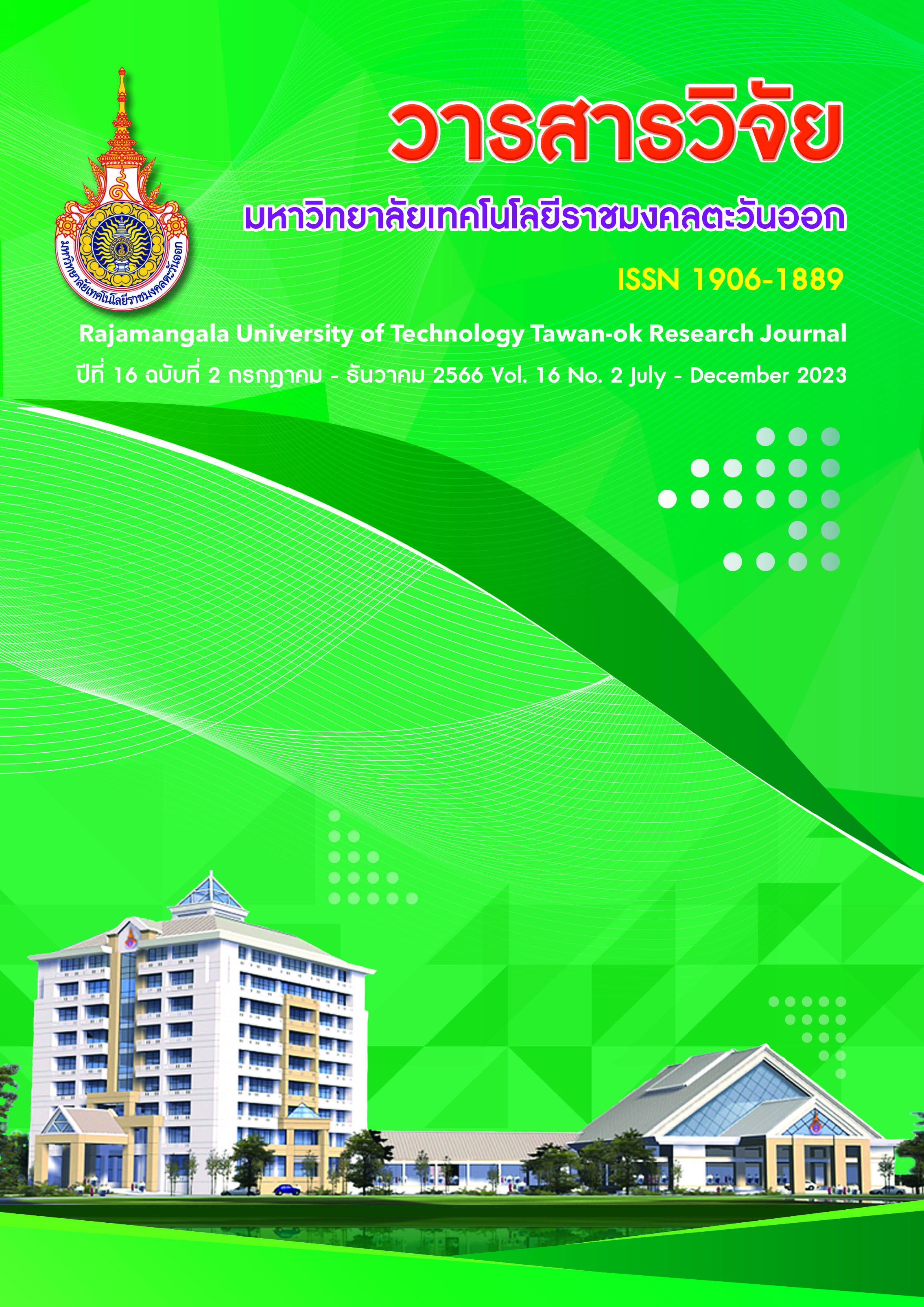การศึกษาความเป็นไปได้ในการใช้รีดิวซ์กราฟีนออกไซด์-เหล็กออกไซด์คอมโพสิต เพื่อการกำจัดโครเมียมเฮกซะวาเลนต์ในน้ำเสีย
Main Article Content
บทคัดย่อ
งานวิจัยนี้ได้ศึกษาความสามารถของรีดิวซ์กราฟีนออกไซด์-เหล็กออกไซด์คอมโพสิต (Fe2O3-x%RGO) ในการกำจัดโครเมียมเฮกซะวาเลนต์ในน้ำเสีย โดยเตรียมสารตัวอย่างคอมโพสิตระหว่างรีดิวซ์กราฟีนออกไซด์-เหล็กออกไซด์โดยวิธีโซลโวเทอร์มอล จากนั้นนำสารตัวอย่างที่ได้ไปวิเคราะห์โครงสร้างทางสัณฐานวิทยาด้วยเครื่อง SEM ส่วนโครงสร้างสามารถวิเคราะห์ด้วยเครื่อง XRD สมบัติเชิงแสงและสมบัติของตัวเร่งปฏิกิริยาเชิงแสงศึกษาด้วยเครื่อง UV-vis การตรวจสอบสมบัติทางแม่เหล็กโดยใช้เครื่อง VSM ผลการวิเคราะห์ด้วยเครื่อง SEM แสดงให้เห็นอนุภาคของเหล็กออกไซด์กระจายตัวอยู่บนผิวของกราฟีนออกไซด์และแทรกตัวอยู่ระหว่างชั้นของกราฟีนออกไซด์ ในส่วนของ XRD พบว่า สารคอมโพสิตรีดิวซ์กราฟีนออกไซด์-เหล็กออกไซด์ แสดงโครงสร้างของเหล็กออกไซด์แบบฮีมาไทล์ (Fe2O3) และผลของ VSM แสดงสมบัติแม่เหล็กแบบเฟอร์โรแมกเนติก ส่วนผลของ UV-vis สามารถนำค่าการดูดกลืนแสงของสารตัวอย่างไปวิเคราะห์ได้ว่าสารคอมโพสิตรีดิวซ์กราฟีนออกไซด์-เหล็กออกไซด์มีค่าแถบช่องว่างพลังงานอยู่ระหว่าง 2.50– 2.80 อิเล็กตรอนโวลต์ นอกจากนี้ผลการวิเคราะห์ประสิทธิภาพการเร่งปฏิกิริยาเชิงแสงของสารคอมโพสิตรีดิวซ์กราฟีนออกไซด์ - เหล็กออกไซด์ในการกำจัดโครเมียมเฮกซะวาเลนต์ในน้ำเสีย พบว่า สารคอมโพสิต Fe2O3-20%RGO สามารถกำจัดสารละลายโครเมียมเฮกซะวาเลนต์ได้ดีที่สุด และการลดลงของความเข้มข้นโครเมียมเฮกซะวาเลนต์ (Cr(VI)) ทำให้ทราบถึงประสิทธิภาพของการเร่งปฏิกิริยาเชิงแสงของสารตัวอย่าง
Article Details

อนุญาตภายใต้เงื่อนไข Creative Commons Attribution-NonCommercial-NoDerivatives 4.0 International License.
เอกสารอ้างอิง
Abasali karaj abad, Z., Nemati, A., Khachatourian, A.M., & Golmohammad, M. (2020). Synthesis and characterization of rGO/Fe2O3 nanocomposite as an efficient supercapacitor electrode material. Journal of Materials Science: Materials in Electronics, 31: 14998-15005.
Ahmad, W.R.W., Mamat, M.H., Zoolfakar, A.S., Khusaimi, Z., & Rusop, M. (2016). A Review on Hematite α-Fe2O3 Focusing on Nanostructures, Synthesis Methods, and Applications. The 13th IEEE Student conference on Research and Development (SCOReD 2016). The IEEE Malaysia Section, and IEEE International Islamic University (IIUM) Student Branch. Kuala Lumpur, Malaysia.
Alice bush. (2018). Iron oxide nanoparticles, characteristics, and applications. Retrieved 5 June 2023, from sigma-aldrich.com.
BBC Thai. (2017). Klity: An old story that made a new chapter in the history of community environmental cases. Retrieved 5 June 2023, from https://www.bbc.com/thai/thailand-41225292. (in Thai)
Board of Dartmouth College. (2004). Iron oxide stoichiometry. Retrieved 5 June 2023, from dartmouth. edu. (in Thai)
Chairot, M. & Panya, P. (2019). Adsorption of hexavalent chromium using Eichhornia crassipes. Proceeding of The 6th National conference KPRU Kamphaeng Phet Rajabhat University Proceeding (pp. 577-586). Kamphaeng Phet: Kamphaeng Phet Rajabhat University. 20 December 2019.
Changsuwan, A. (2019). Hexavalent Chromium in Food. Depatment of Science Service Ministry of Science and Technology, 68(209), 26-28.
Chen, K.-L., Yeh, Y.-W., Chen, J.-M., Hong, Y.-J., Huang, T.-L., Deng, Z.Y., Wu, C.-H., Liao, S.-H. & Wang, L.-M. (2016). Influence of magnetoplasmonic γ-Fe2O3/Au core/shell nanoparticles on low-field nuclear magnetic resonance. Scientific Reports 6: 35477.
Danwittayakul, S. & Thanaboonsombat, A. (2013). Do you already know “hexavalent chromium”, a dangerous substance near you. Materials Technology, 68: 12-18: January - March 2013.
Khamboonrueang D., Srirattanapibul S., Tang, I-M., & Thongmee, S. (2018). TiO2∙rGO nanocomposite as a photo catalyst for the reduction of Cr6+. Materials Research Bulletin, 107: 236-241.
Liang, Y.C., & Hsu, Y.W. (2021). Enhanced Sensing Ability of Brush-Like Fe2O3-ZnO Nanostructures Towards NO2 Gas via Manipulating Material Synergistic Effect. International Journal of Molecular Sciences: 1-12.
Modafferi, V., Santangelo, S., Fiore, M., Fazio, E., Triolo, C., Patane, S., Ruffo, R., & Musolino, M.G. (2019). Transition Metal Oxides on Reduced Graphene Oxide Nanocomposites: Evaluation of Physicochemical Properties. Journal of Nanomaterials Vol 2019: 1-9.
Narawong, W. & Panya, P. (2017). Preparation of Cellulose from Water Hyacinth Leave to Adsorb Cr (VI) Ion. Proceeding of The 4th National conference KPRU Kamphaeng Phet Rajabhat University (pp. 957-966). Kamphaeng Phet: Kamphaeng Phet Rajabhat University. 22 December 2017.
Perumal, S. & N. T. Selvi. (2013). Spectral Evidence for the One-Step Three - Electron Oxidation of Phenyl sulfonyl acetic Acid and Oxalic Acid by Cr (VI). American Journal of Analytical Chemistry, 4: 20-29.
Rahman, M.M., Khan, S.B., Jamal, A., Faisal, M., & Aisiri, A.M. (2011). Iron Oxide Nanoparticles. Nanomaterials. 43-66. Retrieved 5 June 2023, from https://www.intechopen.com/books/861.
Sergey, D., S. Gilje, K. Wang, V.C. Tung, K. Cha, A. S. Hall, J. Farrar, R. Varshneya, Y. Yang & R.B. Kaner. (2010). A One-Step, Solvothermal Reduction Method for Producing Reduced Graphene Oxide Dispersions in Organic Solvents. ACS Nano, 4(7): 3845-3852.
Uma, K., Chong, S., Mohan, S.C., Jothi Venkatachalam, K., Yang, T.C.- K., & Lin, J.-H. (2020). Multifunctional RGO-supported α-Fe2O3 nanocomposites for high-performance pseudo capacitors and visible light–driven photocatalytic applications. Ionics (2020) 26: 3491-3500.
Wang, J.-C., Ren, J., Yao, H.-C., Zhang, L., Wang, J.-S., Zang, S.-Q., Han, L.-F., & Li, Z.-J. (2016). Synergistic photocatalysis of Cr (VI) reduction and 4-Chlorophenol degradation over hydroxylated α-Fe2O3 under visible light irradiation. Journal of Hazardous Materials 311: 11-19.


